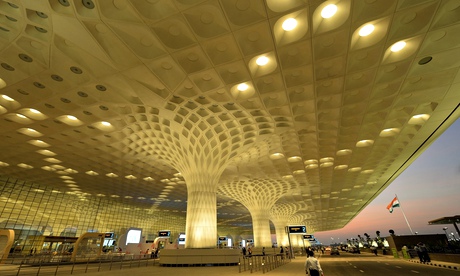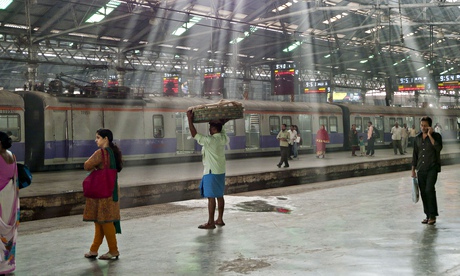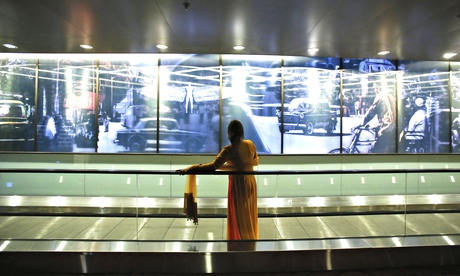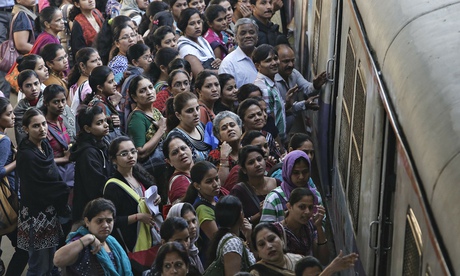Sharing the name Chhatrapati Shivaji, the airport and train terminus have much in common: both were once the future

The new terminal 2 at Chhatrapati Shivaji international airport, in Mumbai. Photograph: Punit Paranjpe/AFP/Getty Images
The long-awaited airport terminal at Mumbai's Chhatrapati Shivaji airport finally opened its aerobridges and check-in counters to passengers this month. In the buildup, any number of journalists had been led on tours through the new facility, and I'd absorbed their reports with a mixture of awe and amusement. The new terminal – the T2 – has 5,000 square metres of landscaping, I learned, and 21,000 square metres of retail space for luxury shops. Some reports also noted that the terminal, which will serve about 40 million passengers each year, will have access to 101 toilet blocks.
In Mumbai, nativists have ensured that almost every new building is named after the 17th-century warrior-king Shivaji, and as I read about the splendours of the new terminal at Chhatrapati Shivaji, I couldn't help thinking about another Chhatrapati Shivaji terminus across town – a hyperkinetic railway station that used to be known as the Victoria terminus.
That terminus is used by 3.75 million people every day, which means it gets as many visitors in 11 days as the terminal at the airport terminal has in a year. But the rail travellers only have access to 83 toilets and urinals – not toilet complexes like the air passengers have, but 83 individual toilets.
When it was opened more than a century ago, however, the Chhatrapati Shivaji railway terminus, which bears an uncanny resemblance to London's St Pancras, was the T2 of its time. It featured state-of-the-art everything, even state-of-the-art art. Its impressive stone façade is alive with sculptures of gargoyles and squirrels and flying birds that were executed under the guidance of Lockwood Kipling, the principal of the JJ School of Art down the road (his son, Rudyard, would grow up to become poet laureate of the empire).
 People on a platform inside Chhatrapati Shivaji terminus, previously known as Victoria terminus, railway station in Mumbai. Photograph: David Pearson/Rex
People on a platform inside Chhatrapati Shivaji terminus, previously known as Victoria terminus, railway station in Mumbai. Photograph: David Pearson/Rex
The new terminal at Mumbai's airport also features a profusion of artworks. Press reports say that more than 7,000 exhibits have been assembled, some by contemporary artists and others from across the ages, reaching back to the 6th century. In fact, the airport website describes the T2 display as "India's largest public art programme". The curator of the collection, Rajeev Sethi, told The New York Times: "The concept of art in public space is a very serious issue because art cannot shrivel up and shrink into investment portfolios or disappear into godowns [warehouses] or galleries. It has to be in the public domain."
The difference between the two terminuses demonstrates just what's going wrong with Mumbai. After two decades of economic liberalisation, its middle class has been so brainwashed into believing privatisation is the solution for all their problems that the city seems to have forgotten what public actually means. As art historian Rahul D'Souza points out: "Richer residents are quite willing to accept the idea that an art exhibition can be public, even if it can accessed only by people who have bought an international air ticket." This attitude will surely have a profound effect on Mumbai's politics in the near future.
The middle-class aspiration for exclusivity is a jarring disjuncture with the mythology and history of a city that lives the best part of its life in full view of its neighbours, with one of the highest population densities in the world (it packs 22,937 people into each square kilometre, compared to 5,285 people in London). The size of the average Mumbai family is 4.5 people, and the average home size is 10 square metres, so some of their most private moments transpire in the midst of a crowd.
Much of Mumbai's easy urbanity has been forged in the sweaty confines of its public transport system, by far the most extensive in India. In its compartments, people of different castes and communities are forced to share benches and be wedged together in positions of daring intimacy. This is only to be expected when 5,000 commuters are stuffed into trains built to carry 1,800 – a density that the authorities describe as the "super-dense crushload". The commonplace negotiations of the commute – such as the convention of allowing a fourth traveller to sit on a bench built for three, but only on one buttock – force an acknowledgement of other people's needs that characterises Mumbai life.
 A woman looks at artwork on display at terminal 2 at Chhatrapati Shivaji airport. The new terminal holds around 7,000 works of art. Photograph: Danish Siddiqui/Reuters
A woman looks at artwork on display at terminal 2 at Chhatrapati Shivaji airport. The new terminal holds around 7,000 works of art. Photograph: Danish Siddiqui/Reuters
The Mumbai commute, in addition to being compacted, is very long – for some, it could involve a journey of two hours each way. This has given rise to the institution of "train friends", people who travel in a group in the same section of the same compartment every morning, sharing stories of their triumphs and disappointments and even celebrating their birthdays by bringing in sweets for their companions.
Despite the enormous effort they sometimes entail, the accommodations of the commute are barely perceptible to the outsider. Because of the unavoidable press of bodies at peak hours, women travel in separate carriages – but every so often, couples who cannot bear to be parted or a clueless out-of-town pair will blunder into the "general compartment". When this happens, the other men will strain to provide the woman a millimetre or two of space around her, creating a cocoon in which she is magically insulated from the accidental nudge of limbs and torsos.
This isn't to suggest that life on the rails is all smiles and sunshine. As is to be expected on a long, sweaty journey, arguments do break out, mostly over trivial matters involving the placement of a limb or a bag in awkward proximity to a fellow passenger's face. But these exchanges rarely culminate in fisticuffs. The crowd around the belligerents can be counted on to defuse the tension quickly, usually with the remark, "These things happen. You have to adjust".
Sadly, though, the spirit of compromise so evident on the trains is evaporating on the streets outside. To watch Mumbai traffic in motion is to see the ferocious sense of entitlement in which India's moneyed classes have wrapped themselves. Mumbai's vehicles refuse to give way to ambulances, and honk furiously at old people and schoolchildren trying to cross the street. They never stop at zebra crossings, frequently jump red lights, and routinely come down the wrong way on no-entry streets. Because an estimated 60% of cars are driven by chauffers, more than in most other parts of the world, car owners have the fig-leaf of pretending that they aren't responsible for transgressions they actually encourage. And this sense of self-importance is pandered to by the government's budgetary allocations. Though the vast majority of Mumbai residents use the overburdened public transport system to get around, a disproportionate amount of development money has been poured into road projects.
 Female commuters wait to cram into a ladies only carriage on a rush hour train from Chhatrapati Shivaji rail terminus. The trains were designed to carry around 1,800 passengers, and currently hold around 5,000 per journey. Photograph: Danish Siddiqui/Reuters
Female commuters wait to cram into a ladies only carriage on a rush hour train from Chhatrapati Shivaji rail terminus. The trains were designed to carry around 1,800 passengers, and currently hold around 5,000 per journey. Photograph: Danish Siddiqui/Reuters
The city has built approximately 60 flyovers and elevated roadways in recent years – facilities that have paradoxically made the congestion on the roads far worse. As incomes expand, traffic is growing at a rate of 9% a year, with an estimated 450 new vehicles being added to Mumbai's narrow streets every day. As a result, peak-hour traffic crawls ahead at an average of 10kmh – less than half the speed clocked by winners of the city's annual marathon. It merely proves the adage so beloved of planners around the world: "Building more roads to prevent traffic congestion is like a fat man loosening his belt to prevent obesity."
The imbalance so apparent between Mumbai's transport system and its airport seem sure to polarise political attitudes in the city even more sharply. The city's middle classes have become so enamoured of their privatised comforts, they are forgetting that great cities get their reputation not from the access-restricted pleasures they afford the few, but the public amenities that are available to all. The chasm between the elite and the working classes has long been the playground for populist politicians, here and elsewhere. But over the last few years, such divisions in Mumbai have literally been reinforced by concrete. Unless this changes, my city will lose the common ground on which to make common cause.
Very good info. Lucky me I came across your site
ReplyDeleteby accident (stumbleupon). I have saved it for
later!
My website ... apartments in atlanta